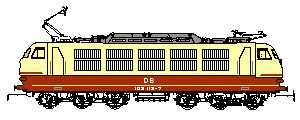
MOST RECENT PICTURES OF MÄRKLIN LOKS ON MY LAYOUT

MOST RECENT PICTURES OF MÄRKLIN LOKS ON MY LAYOUT
Click on any small picture to see large pictures of the engine. Click on any large picture to return to this screen.
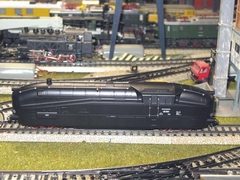
P
ictures of the Marklin 39619 BR 61 black streamlined tank lok. This train was originally built to compete with the diesel railcar trains such as the "Flying Hamburg." The lok was built by Henchel. The first lok was the 61001. The first ride of the train was on 13 June 1936 as D53/54 and D57/58 between Berlin Anhalter Bf and Dresden Hbf. Because of its lightness it reached speeds of up to 100 mph or 160 km/hr. Its average speed on these this route was 66 mph or 106 km/hr. The 61001 was retired in 1951 after being damaged.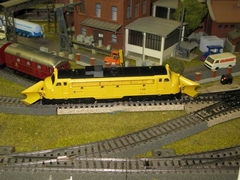
P
ictures of the Marklin 37662 Type Di3 628 Norwegian Snowplow Diesel on my layout. This is a NoHAB lok outfitted with a large snow plow at each end. There is a special very bright headlamp to warn oncoming trains that the plow is approaching. The two plows at each end give the lok a distinctive lok as does the bright yellow livery. It has a nice diesel sound with braking sounds as well.P
ictures of the Märklin (39080) BR VT8.05 railcar set with the added car which carried the 1954 German soccer team from it World Cup victory. The consist runs smoothly with great sounds. The F5-F8 sounds include a radio announcement of Germany's victory as well as a train call announcement, the "all aboard" whistle, and the doors clossing sounds.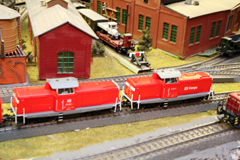
P
ictures of the Märklin (37726) DB Cargo Class 212 and Class 213 diesel loks. These loks are connected in tandem each with its own motor and decoder. (Unlike the Class 151 tandem loks which have only one powered lok and a dummy.) They can be separated but currently they are connected with the same decoder number. They run smoothly with neither lok out running the other. They do not have any sounds which is disappointing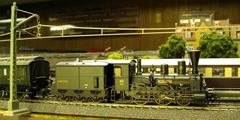
P
ictures of the Märklin (37974) Royal Bavarian State Railways (K.Bay.Sts.B) B VI peat lok. These loks were constructed between 1863 to 1871 and were the backbone of the K.Bay.Sts.B. They were used for express and mail trains. Intially the lok had only a canopy and the steam pressure was only 116 pounds. These orginal loks were upgraded with a cab and the pressure of the boiler raised to 145 pounds. These loks burned peat which had to be kept dry, hence the enclosed tender. Peat burning loks tended to create more sparks and so he smoke funnel was usually pear or balloon-shaped.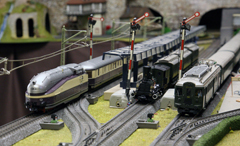
P
ictures of the Märklin (26610) Henchel-Wegmann [Henschel-Wegmann] lok set. This is not one of Märklin's best efforts. It is hard to regulate the chuffing sound. The lok does not like M track, especially curves - I have a mix of mostly C but some M where the geometry just didn't match. The sound is the same steam sound that you get in most Märklin steam loks. The cars are plastic and the paint job is not the best. A disappointment that I will make the best of.P
ictures of the Märklin (37490)GG1 in green and the Märklin (37491) GG1 in metal. Both have an mfx decoder which has 16 sounds and functions when used with a Central Station (CS). Using a Lok Sound Programmer 2 Robert Frowenfeld changed some of the sound slots so that I can access them with my IB. He moved some of the F9-F10 functions to F1-F4 functions including cab chatter. Using an IB you can normally access the F5-F8 functions through decoder 26 but you can't get beyond those functions without using the CS. I did not change the metal GG1 sound slots so they can be accessed using my Mobile Station (MS) which I have attached using the Uhlenbrock MS adapter or through the IB using decoder #26. This adapter when connected to my LocoNet only has unidirectional communications with the loks on the tracks.Click on the image above to see pictures of the GG1.
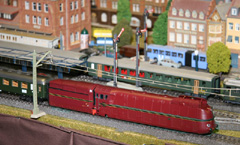
P
ictures of the Märklin (37050) BR 05. The combination of the power of the BR 05 and its streamlining reaching a speed of 200 km/hr or 125 mph in May 1936. The lok was placed into regular service and were later overhauled and returned to service in 1951. The streamlining was removed at that time. There were two BR 05's built and both were retired in 1958. One is in the Nürember Transportation Museum. This steam lok runs well, sounds great and is a nice addition to my layout.Click on the image above to see pictures of the BR 05.
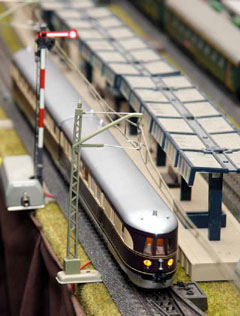
P
ictures of the Märklin (37770) "Fliegender Hamburger" SVT 877 diesel railcar. The orginal Flying Hamburger was the VT 877 built in 1933. It was intended to provide high speed rail service between Hamburg and Berlin. The VT 877 reached speeds of 150 km/hr or 100 mph making it the fastest passenger rail service of its time. The SVT 137 was built in 1935/36 and continued in service until World War II. It resumed service in 1949. The rail car is actually an electric rail car with diesel motor to generate th electricity for its motors. The Märklin lok has an MFX decoder. This lok runs great. There is a video showing the lok running on the City Section of my layout.Click on the image above to see pictures of the "Fliegender Hamburger" SVT 877.
 Revised:
Revised:
P
ictures of the Märklin 37972 "Old Time" lok, BR 34.3472.
P
ictures of the SpanishClick on the image above to see pictures of the Velaro.
P
ictures of the Märklin (37082) V100 diesel switcher. This lok has been retrofited with a Lok Sound diesel decoder. This lok runs great and sounds great. The pictures show it pulling a consist of log and lumber cars. There are two videos showing the lok running on the industrial section of my layout.Click on the image above to see pictures of the V100.
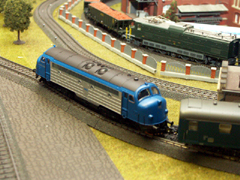
P
ictures of the Norddeutsche Eisenbahngesellschaft (NEG) V170 diesel-electric lok (Märklin 34666) pulling the 3 car Hilfswagen set (Märklin 49951) wrecking train or crane tender cars. These cars were painted "ocean blue" but are now painted red. These cars go with the Goliath crane. There are also two Roco hilfswagen cars (44817 & 44818) that are also part of the consist. The two Roco cars were meant to be used with the Roco digital crane car. The center car of the three car set has sounds of grinding, compressed air screw drivers, bending metal, metal sawing, jolt-ramming and welding. With the welding sounds a blue light flashes.Click on the image above to see pictures of the NEG V170 and the Hilfswagen set.
P
ictures of the Märklin (37082) Insider red BR 10 steam lok reserved for 10 Year Members of Insider Club. This is one of the nicest looking loks that Märklin has produced. It has a great whistle sound and a really good chuffing sound which is syncronized to the rotation of the wheels. You can set the chuffing sound to 3 chuffs per wheel rotation or 6 chuffs as you can with the black Insider (37080) lok. I prefer the 3 chuff mode. The decoder is in the tender making it easy to set the accelereation/deceleration speeds and the lok decoder number. I will install a Seuthe smoke unit to really make the lok look great. The sound, detailing and running characteristics make this among my favorite loks. The pictures show this lok pulling a consist of three "South-wind coaches".Click on the image above to see pictures of the red BR 10.
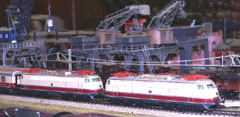
P
ictures of two Märklin TEE BR 103's (39573) pulling a consist of TEE coaches including the digital waiter car. These electric loks are the 2002 loks that have a whistle (horn) that has an echo effect. The F2 function turns on roof vent lights that look neat. I have set the decoders to the same numbers so they pull in tandem. They work quite well double-heading. I have set the acceleration/deceleration for both loks to be as close as possible.The consist includes a TEE Panorama waiter car. Function buttons send the waiter down the car, turn him around and return him to his original position. This car and the dance car are special pieces in my connection.
Click on the image above to see pictures of the BR 103's.
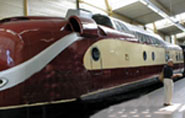
P
ictures of the Marklin TEE VT 11.5 601 (37605) which is four car diesel set. It has really great diesel sounds in both the front and rear cars. The F1 function turns on the diesel sounds. The F2 function turns on the interior lights of the coaches. The horn is controlled by the F3 button. F1 turns the sound on. When you change direction there is a change over sound that I really like. The body of the loks are metal as opposed to plastic in the Roco VT 115 set.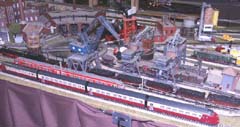
P
ictures of the Märklin RAm TEE 1 (39700) diesel set and the RAm TEE 1 (3071). The 39700 is the latest RAm TEE 1 set that Märklin has issued. The first was the 3071 followed by a Delta set, 3471, and now the 39700. The F2 and F3 functions control two different horn sounds. There is a difference between this set and the original 3071 - the 39700 has a black roof while the 3071 has a silver roof.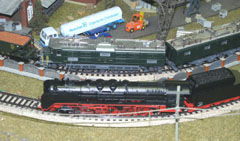
P
ictures of the Marklin (37450) Insider BR 45 lok. This is a really nice lok with steam sounds, a great whistle, a glowing firebox and outfitted with a Seuthe #11 smoke unit. The BR 45 is seen on my layout pulling a consist of various types of hopper cars, some filled with coal. The lok pulls this consist of 24 cars with ease.The Class 45 was first built in 1937 by Henschel with only two loks. The BR 45 has a 2-10-2 wheel configuration or a 1'E1'-h3 configuration. (Click on the underlined material above and below to link to Kurt Miska's site for helpful information on wheel configuration and service class categories.) It was a freight lok, service class G 57.18/20, built to sustain 90 km/hr or 56 mph with heavy loads. 26 loks were built in 1940/41 for a total of 28. None were built after that as the BR 41 became a priority for the German State Railroad.
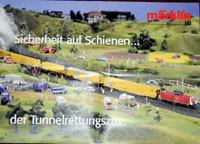
P
ictures of the Marklin (26510) rescue train set (Tunnelrettungszug zugpackung). This DB train is used to fight tunnel fires and for rescues in a tunnel. It consists of two Class 714 diesel loks and five specialized cars - a transport cars at each end next to each lok (transportenwagen), one equipment car (gerätenwagen), one fire extinguisher car (löschmittelwagen) and one first aid car (sanit"a"tswagen). The train has a Class 714 at each end. The train is pushed into the tunnel with its own air supply system. When the train and its crew reach the site of the fire they place persons needing first aid in the the transport car closest to tunnel opening. The lok and this car is detached from the rest of the train and pulled out to the rear staging area. On the Marklin set there is a Telex coupler on this transport car which allows it to be uncoupled from the rest of the consist.This set has one powered lock which pushes the consist into the tunnel and an unpowered lok. The consist has three decoders. One in each of the loks and one in the transport car with Telex. The powered lok and the transport car decoders are set at the same number (33 factory) and the decoder in the unpowered lok is a different number (34). The functions control emergency blinking lights are each lok, an emergency blinking light at end of the transport car with the Telex, and side lights on both transport car. The cars on this set are connected with current-conducting couplers except on the first transport car which has a Telex coupler. This is a really nice set.
P
ictures of the Tragschnabelwagen (the Schnabel transformer transport wagon) (Trix 23994) pulled by a DB V288 Diesel Electric (Märklin 37284). This is an Era IV wagon. The actual prototype was purchased in 1973 by the German Federal Railways (DB). It consisted of two Uai 839 cars capable of suspending a very large, heavy transformer between them. It measured 63.28 meters or 207 feet. It was the largest freight car(s) in Europe. It had 32 axles. For comparison purposes, the torpedo car has 18 axles.In actual use, many catenary masts and signal masts had to be taken down and bridges had to be raised in order to allow the car(s) to pass. On dual tracks only this train was allowed to run for fear it would hit trains on the other track as it rounded curves. The load can be sifted by hydraulics, right or left, to allow for passage in tight spots.
The car(s) is(are) the largest on my layout. I thought the torpedo car was long. This dwarfs the torpedo car. It is 720 mm or 28 3/8 inches over buffers. It extends quite a bit over the track bed especially as it rounds curves. A tip to all who are building a layout with catenary and signal masts, all signal masts and catenary masts must be on the outside of the curve to allow this monster to pass. You have to see the pictures of this behemoth on my layout to appreciate how much of an overhang there is. Unfortunately, if you have the Big Boy you must have the catenary and signal masts on the inside to allow for the overhand of the front boogie.
The DB V288 Diesel Electric (Märklin 37284) is a powerful lok that probably would have just been going out of service when the tragschnabelwagen was first put in service. It was originally a V 188 but after retrofitting it left DB service as the V 288. This lok has nice sound and great performance. As the pictures show, it was able to push the tragschnabelwagen up a 4% grade with no problem. Nice as the tragschnabelwagen is, it will not see a great deal of running time on my layout. There are just so many large transformers to be delivered and I currently have all that I need right now.
The transformer can be removed and the two Uai 839's can be connected. Sounds simple but it took me 30 minutes to remove the transformer and connect the two Uai 839's. There are small parts that kept falling out of there slots. The process is not one I want to do again. I think the transformer stays where it was dropped off on the layout. Without the transformer the two connected Uai 839's do not extend as much and can run on more of my layout.
Surprisingly, though it can only run in a limited part of the layout, it has run well, even on my M track layout. I did not retrofit the wheel sets with Märklin wheels. It is running on the Trix wheels.
P
ictures of six of my eight ICE triebwagens. The pictures are of the DB ICE 3, the NS ICE 3, the DB ICE sine, the DB double ICE 2, the DB ICE 2, the DB Elisabeth ICE. Not shown are my ICE 1 and the Amtrak ICE which are both in storage.P
ictures of the Bavarian State Railroad Gt 2 4/4 (BR 96) tank lok with a consist of freight cars.P
ictures of Märklin (37080) Insider BR 10 steam lok. This is one of the best loks that Märklin has produced. It has a great whistle sound and a really good chuffing sound which is syncronized to the rotation of the wheels. You can set the chuffing sound to 3 chuffs per wheel rotation or 6 chuffs. I prefer the 3 chuff mode. The decoder is in the tender making it easy to set the accelereation/deceleration speeds and the lok decoder number. I am waiting for the Seuthe smoke unit which will really make the lok look great. The sound, detailing and running characteristics make this one of my favorite loks. I like this dampflok so much that I have purchased a second one.Click on the image above to see pictures of the black BR 10.
To appreciate the sound I have created a short MPEG video file which runs with Real video viewer. It may take a while to load the file but when it runs you will see and hear the chuffing sound synchonized with the engine speed.
Click here to see and hear the BR 10.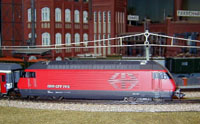
P
ictures of the SBB CFF FFS 2000 Class 460 electric lok (Märklin 3760) and a consist of passenger coaches. The coaches are from a special set (Märklin 4367, issued in 1994) of six cars including one 1st class coach, two 1st observation cars, a "Le Buffet" car" and two 2nd class coaches. I have added a special salon car (Märklin 42157) which was used when the Pope visited Switzerland. Recently Märklin issued a control cab (42178) which I have added to the set. I have pictures of each coach as well as several pictures of the lok. I intend to change loks for this consist by using one of the many 460's with advertising on them such as the Tilster Cheese engine. I have several HAG 460 with special livery as well which I will also use.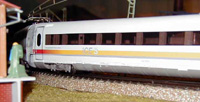
P
ictures of Märklin (39710) ICE Sine engine set as it travels over my layout. This engine has a special sine motor. The engine set was available to a select group chosen by lottery. The winners were asked to test and evaluate the engine. I ran the engine as requested and found that it performed flawlessly. It climbed a 5% grade with no problem at a speed of 8. I stopped it on the incline and restarted it at a speed of 2 with no problem. The engine started on a level surface at a speed of 2 as well. The engine rolls to a smooth stop within ten centimeters. Acceleration and deceleration was very acceptable.P
ictures of two Märklin Class 151 electric loks, Märklin 37432. These engines have two sounds, a great whistle and the sound of squealing brakes. One of the loks is powered, the other is unpowered. The consist is made up of Märklin and Roco cars. There are two Cargo info cars behind the tandem 151's. The engines are seen pulling ten cars with no problem. A great looking consist.